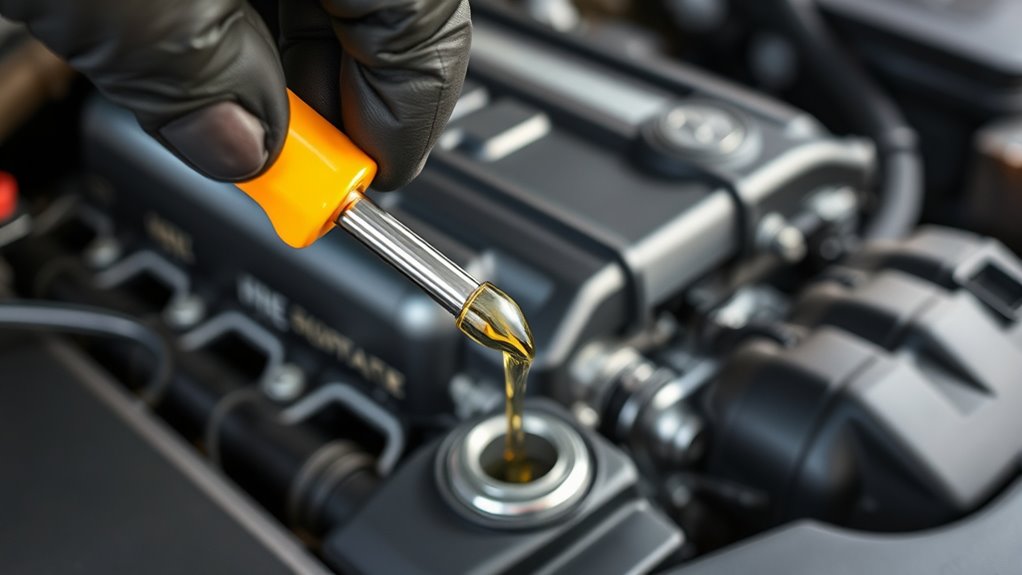To check your car’s engine oil, park on a level surface, turn off the engine, and wait a few minutes for the oil to settle. Open the hood, find the dipstick, and pull it out, then wipe it clean. Reinsert it fully, pull it out again, and check the oil level against the marks. Make sure the color is clear and add oil if needed, but avoid overfilling; proper maintenance is key.
Key Takeaways
- Park on a level surface, turn off the engine, and wait a few minutes for the oil to settle.
- Locate the dipstick, pull it out, and wipe it clean with a rag or paper towel.
- Reinsert the dipstick fully, then remove it again to check the oil level between the min and max marks.
- Examine the oil color and consistency; it should be translucent amber, not dark, thick, or milky.
- Add oil slowly if below the minimum level, avoiding overfilling, and recheck the level to ensure proper fill.

Wondering how to guarantee your car runs smoothly? The key is to regularly check your engine oil. This simple task guarantees your engine stays well-lubricated, preventing potential damage and costly repairs. Start by parking your car on a level surface and turning off the engine. Wait a few minutes to let the oil settle back into the oil pan, which gives you an accurate reading. Open the hood and locate the dipstick, usually marked with a bright handle or labeled as “oil.” Pull it out completely and wipe it clean with a rag or paper towel. Then, reinsert the dipstick fully and pull it out again to check the oil level. You should see oil on the dipstick, but not to the very top or bottom. The ideal oil level is usually between the minimum and maximum marks. If it’s below the minimum, you need to add oil; if it’s above the maximum, you might have overfilled, which can cause problems.
Next, examine the oil’s color and consistency. The oil should be a translucent amber or light brown. Fresh oil is typically a golden hue and free of debris. If the oil appears dark brown or black, it’s a sign that it’s broken down and may need changing. Thick, gunky oil indicates it’s accumulated dirt and contaminants, which can reduce its lubricating properties. Also, watch for any milky or foamy oil, which could suggest coolant leaks or water contamination. Consistently checking the oil color helps you determine whether your oil is still effective or if it’s time for an oil change. Regular oil checks are also important because silly mishaps like spills or contamination can happen unexpectedly, affecting your engine’s health.
Regularly inspecting your oil level and color is a straightforward way to catch potential issues early. If the oil level is low, add the recommended type of oil for your vehicle, pouring it slowly into the oil fill cap while the engine is off. Keep checking the level until it reaches the appropriate mark. Remember, never overfill, as too much oil can cause engine damage. If you notice the oil color is abnormal or the level is consistently dropping, it’s a good idea to visit a mechanic for a thorough inspection. By staying attentive to these simple checks, you help ensure your engine runs efficiently and prolong its lifespan. Checking your engine oil might be quick, but it’s an essential habit that keeps your car running smoothly day after day.
Frequently Asked Questions
How Often Should I Check My Engine Oil?
You should check your engine oil regularly, ideally once a month, to guarantee it stays within proper levels. Follow your car’s recommended oil change intervals, usually every 3,000 to 5,000 miles, but also rely on your oil life monitor for accurate guidance. Regular checks help you catch low oil levels or contamination early, preventing engine damage and maintaining peak performance.
Can I Check My Oil Without a Dipstick?
You can check your oil without a dipstick if your car has an oil sensor, which alerts you to low oil levels. To do this, turn on your vehicle and look for the oil level indicator on your dashboard. You can also remove the oil cap and inspect the oil’s appearance and level visually, but relying on the oil sensor provides the most accurate reading without traditional tools.
What Type of Engine Oil Is Best for My Car?
Did you know that synthetic oils last up to 2-3 times longer than conventional ones? For your car, synthetic oils are often best because they provide better engine protection and fuel efficiency. Consider using oil additives if your engine needs extra care, but always choose the type recommended by your manufacturer. This guarantees ideal performance and longevity, helping you avoid costly repairs later on.
How Do I Know if My Oil Needs Changing?
You can tell if your oil needs changing by checking its color and consistency. If it looks dark, gritty, or has sludge, it’s time for a change. Oil additives can break down over time, reducing effectiveness. Synthetic oils last longer than conventional, but both need replacing eventually. Regularly inspecting your oil level and quality helps guarantee your engine stays well-lubricated and runs smoothly, preventing costly repairs.
Why Is My Engine Oil Level Dropping Quickly?
Did you know that, on average, engines consume about 0.5 to 1 quart of oil every 1,000 miles? If your engine oil level drops quickly, it could be due to increased oil consumption or a leak. Regularly check for leak detection and monitor oil levels to prevent engine damage. Addressing these issues early helps maintain your engine’s performance and prolongs its lifespan.
Conclusion
Now that you’ve learned how to check your car’s engine oil, you’re like a skilled captain steering through a sea of mechanics. Regularly monitoring your oil keeps your engine humming smoothly, preventing it from running aground. Think of it as giving your car a health check-up — simple, quick, and essential. With this knowledge, you’re all set to keep your vehicle sailing smoothly on every journey, ensuring it stays strong and reliable mile after mile.









